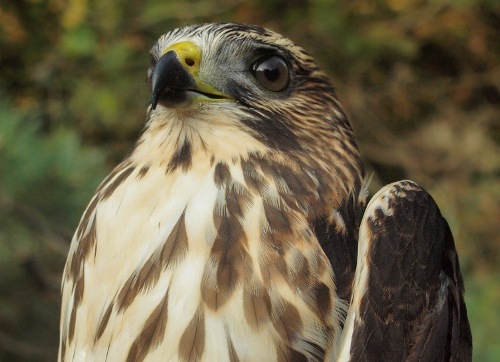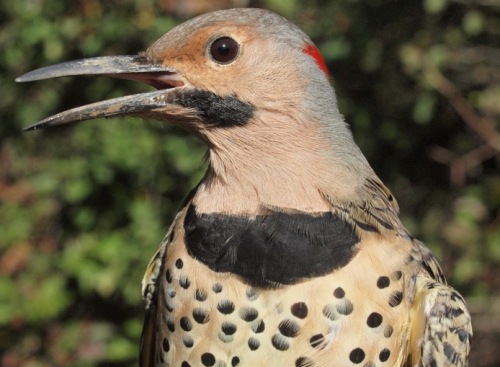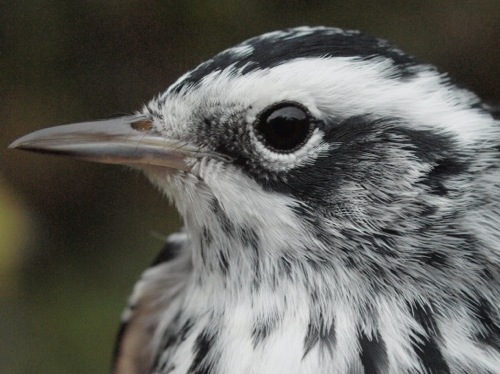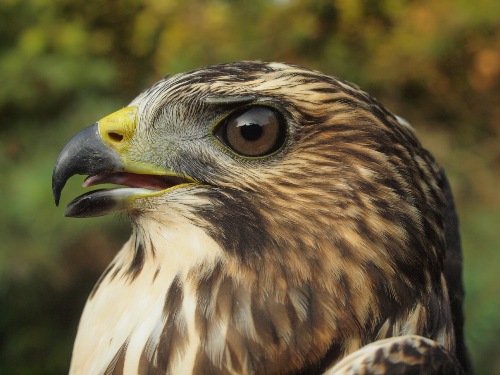|
Week 6: September 5-11, 2014 |
Welcome
to the McGill Bird Observatory weekly report.
Click here for a complete listing of our archives.
Comments or
questions are welcome at "mbo AT migrationresearch.org".
|
PICTURE
OF THE WEEK: |
|

In terms of absolute numbers, Broad-winged Hawk is the most abundant raptor observed
at MBO in most years, thanks to large flocks of them migrating overhead each September.
However, none of us can recall ever seeing one perched on site - so catching this one was
quite a surprise! It became the 115th species banded at MBO
(Photo by Simon Duval)
-
|
|
|
THIS WEEK |
THIS FALL |
2014 TOTAL |
SITE TOTAL |
|
# birds (and species) banded |
223 (40) |
1269 (61) |
2768 (81) |
49078 (115) |
|
# birds (and species) repeat |
69 (19) |
315 (36) |
654 (50) |
9788 (70) |
|
# birds (and species) return |
2 (2) |
35 (16) |
175 930) |
1609 (38) |
|
# species observed |
85 |
120 |
151 |
209 |
|
# net hours |
474.0 |
1240.1 |
1240.1 |
80423.4 |
|
# birds banded / 100 net hours |
47.0 |
36.3 |
36.3 |
58.1 |
|
|
Note: table does not include nocturnal banding (owls) |
|
Banders-in-charge: Simon Duval and Gay Gruner
Assistants: Angelika Aleksieva, Veronica Aponte, Cindy Bouchard, Manon Bourdon, Claude Cloutier, David Davey, Jean Demers, Leah den Besten, Barbara Frei, Marcel Gahbauer, Pedro Grillo, Alison Hackney, Lisa Keelty, Helen Kohler, Marcel Lebeau, Catherine Legault, Valentin Lucet, Barbara MacDuff, Betsy McFarlane, Ana Morales, Clémence Soulard, Patricia Stotland, Sophie Tessier, Elise Titman, Rodger Titman, Christiane Tremblay
Notes:
The volume of migration in week 6 has varied greatly over the years, with as few as 109 and as many as 416 birds banded; this year’s count was somewhat below average, and the season total to date is lower than it has been at this point in the season since 2009. However, the number of species observed remains well above average for another week. The 69 repeats this week was a record high for week 6, so we were quite busy, even though a lot of the action was repeat visits from birds stopping over at MBO for a bit before resuming their southward migration.

Last fall we did not band a single Yellow-shafted Flicker; this year our count is already up to three, including this and one other over the past week.
(Photo by Simon Duval)
|
While we did not observe any new species for the year this week, we added two raptors to our tally of species banded at MBO in 2014 – Sharp-shinned Hawk and Broad-winged Hawk … and the latter was our first ever, increasing our site total to 115 species banded. Over the course of the week we also banded the first Warbling Vireo of fall (long overdue – usually present in early August), as well as Chipping and Lincoln’s Sparrow.
This week’s top 10 [last week's rank in brackets]
# individuals banded |
mean # individuals observed daily |
1. American Goldfinch (44) [7] |
1. American Goldfinch (34) [1] |
2. Magnolia Warbler (27) [2] |
2. American Robin (27) [3] |
3. Red-eyed Vireo (26) [3] |
3. American Crow (24) [2] |
4. Tennessee Warbler (12) [1] |
4. Black-capped Chickadee (18) [4] |
5. Gray Catbird (11) [9] |
5. Cedar Waxwing (16) [8] |
5. American Redstart (11) [5] |
6. Canada Goose (16) [5] |
7. White-throated Sparrow (10) [-] |
7. Blue Jay (14) [-] |
8. Northern Waterthrush (8) [-] |
8. Red-eyed Vireo (9) [10] |
9. Black-capped Chickadee (7) [-] |
9. Gray Catbird (8) [7] |
10. Ovenbird (6) [5]
10. Common Yellowthroat (6) [4]
10. Song Sparrow(6) [-]
|
9. Magnolia Warbler (8) [9] |
|
There was quite a shake-up in migration this week, with American Goldfinch making a sudden leap to the top of the list – quite a surprise in that in more than half of previous years, it was not even among the top ten species at this time of year, and the highest count for week 6 until now was 20 individuals banded in 2007. Magnolia Warbler, which was the top species in week 6 in seven of nine previous years, held steady from last week in second place, but Tennessee Warbler tapered off considerably from last week. Meanwhile Red-eyed Vireo numbers remained well above average, with the season total rising to 88, already the third highest fall total, and with more no doubt yet to come. Similarly, Gray Catbird is on a great pace, with 58 banded already this fall, getting close to the season record of 64, and with at least a few more weeks before their migration ends. It was a bit surprising to have another 7 “new” chickadees at this point in the season … perhaps local dispersal, or maybe an early sign of a chickadee migration to come this fall.
For just the second time this season, American Robin got pushed back to second place on the list of species observed, but for the third week in a row it was joined in the top three by American Goldfinch and American Crow. The middle of the pack was occupied by the same four species as last week – Black-capped Chickadee, Blue Jay, Cedar Waxwing, and Canada Goose, while Magnolia Warbler and Red-eyed Vireo remained in the bottom part of the top ten – the only change being the addition of Gray Catbird in place of Tennessee Warbler.
|

A close-up view of one of the Black-and-white Warblers banded this week.
(Photo by Simon Duval)

Another look at MBO's first Broad-winged Hawk.
(Photo by
Simon Duval)
|




